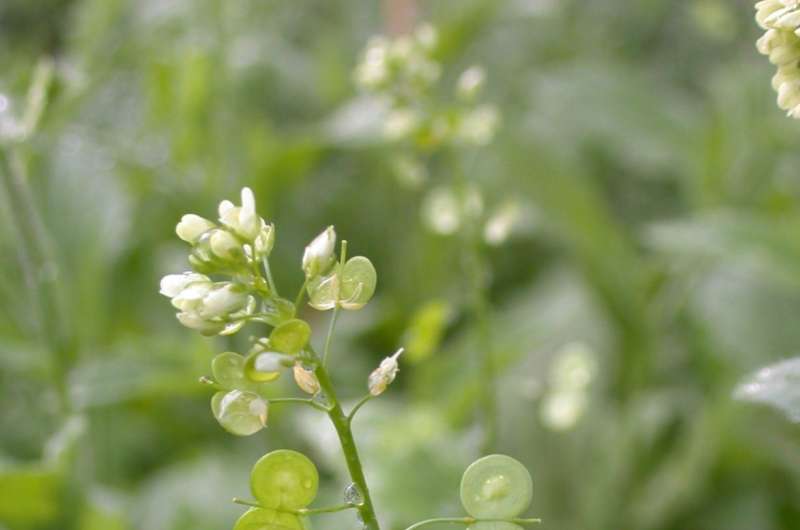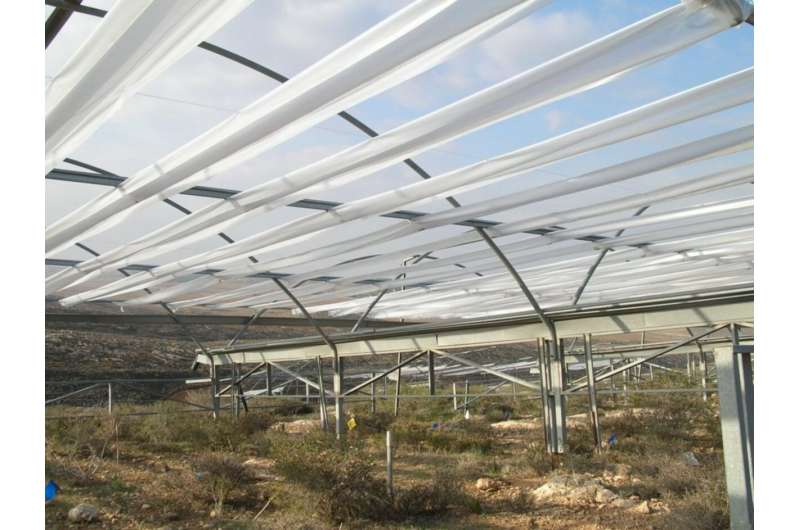The focal plant species (Biscutella didyma). Credit: University of Tübingen
Certain plant species can evolve very quickly under drought conditions. This means that the modified plant traits are genetically fixed and passed on to the next generation. A research team led by Professor Katja Tielbörger from the Institute of Evolution and Ecology, together with other colleagues from the University of Tübingen and the Universities of Hildesheim, Münster and Cologne, has shown this in a new study. However, the plants in the experiment were not able to quickly adapt all important traits to the lack of water. The study has been published in the journal Ecology Letters.
Anthropogenic climate change is progressing faster and faster, leading to higher temperatures and altered precipitation. For many regions that are already very dry today, such as deserts or semi-deserts, climate scenarios predict even lower precipitation levels. In order to survive under these new conditions, organisms must adapt very quickly.
Tielbörger's research group could build on a unique long-term experiment in Israel to investigate whether and how plants can realize such rapid adaptation. For twelve years, the precipitation was manipulated for entire plant communities in the field, either by providing additional irrigation or by reducing the rainfall using special rainout shelters. "Such long-term experiments are rarely conducted. That's why there are hardly any studies in which the evolution of plants can be investigated under near-natural conditions," says Tielbörger. In an earlier study, the scientist had already found that the plant communities were extremely resistant to drought, and she then suspected that this could be partly due to rapid adaptation of the predominantly annual species.
Long-term experiment in a semi-desert environment in Israel: the response of entire plant communities to experimental drought and increasing rainfall was studied for twelve consecutive years. The pictures show rainout shelters which reduce the incoming rain by 30 percent. Credit: University of Tübingen
In the current study, Tielbörger's team focused on a small annual crucifer (Biscutella didyma), a species that occurs in extreme deserts up to rather wet Mediterranean regions. "We have looked at a large number of traits whose genetic information has been well researched and which have a huge influence on the plant's ability to withstand drought," said Tielbörger. A special feature of the long-term experiment was that it included four locations along a very steep rainfall gradient. The research team investigated the plant traits that change along the gradient and compared them with the response of the plants to the experiments.
The speed of adaptation differed among traits
The researchers observed that within only ten years, plants originally adapted to more humid condi-tions developed an earlier flowering time under artificial drought and put more resources into seed production. "These are classic adaptations to very dry conditions, such as those found in desert plants," explains the scientist. "Thus, the experiment gives us a strong indication that the evolution of these properties was indeed an adaptation to climate change." Interestingly, there were also several vital traits that did not evolve in the experiment, such as water use efficiency or seed dormancy.
"The message of our study is therefore only partly optimistic," says Tielbörger. "Although we were able to show that rapid evolution is possible for important plant traits, there are also traits for which the adaptation processes may be too slow to keep pace with climate change."
More information: Rapid adaptive evolution to drought in a subset of plant traits in a large‐scale climate change experiment, Ecology Letters. doi.org/10.1111/ele.13596
Journal information: Ecology Letters
Provided by University of Tübingen

























